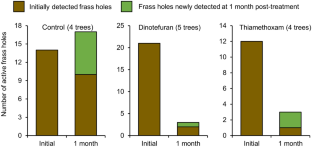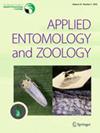Effects of neonicotinoid insecticide trunk injections on non-target arboreal ants, potential biological control agents for invasive longhorn beetle Aromia bungii on cherry trees
Abstract
Trunk injection is a relatively new, environmentally friendly method to apply insecticides to trees which does not cause insecticide drift and environmental runoff. However, little is known about the effect of insecticide trunk injection on non-target arboreal ants (Hymenoptera: Formicidae) which can act as biological control agents of target tree pests. This study evaluated the effect of trunk injections on arboreal ants found on cherry trees treated with neonicotinoids (dinotefuran and thiamethoxam) for controlling the invasive longhorn beetle Aromia bungii (Faldermann) (Coleoptera: Cerambycidae). Arboreal ants represented by Crematogaster matsumurai Forel can prey on A. bungii eggs. Results of visual sampling 1 and 3 months after injections showed that injections did not reduce the number of ant species occurring on tree trunks. Additionally, injections did not eliminate 3 of 4 most abundant species on tree trunks or extrafloral nectaries including C. matsumurai. However, a decline of Lasius japonicus Santschi was observed on injected trees. Our preliminary short-term survey suggests the possibility that chemical control by trunk injection and biological control by arboreal ants are compatible in A. bungii management. However, further research is needed to clarify the mechanism of L. japonicus decline and long-term consequences of trunk injection on arboreal ant composition.


 求助内容:
求助内容: 应助结果提醒方式:
应助结果提醒方式:


